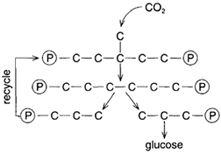The Calvin Cycle
Recall now what F.F. Blackman observed in 1905: in certain situations, the rate of photosynthesis is governed by temperature, indicating that the chemical changes of photosynthesis are controlled by enzymes. Such reactions are the so-called dark reactions of photosynthesis. Carbon is converted to carbohydrate during the dark reactions.Melvin Calvin (1911-1997) used a radioactive isotope of carbon, C14, to trace the carbon of carbon dioxide as it went through several intermediate changes. He very briefly exposed the cells of algae to carbon dioxide that had been manufactured with radioactive C14. This made it possible to trace where this carbon went on its pathway to carbohydrate. Catching the C14 in an intermediate compound was accomplished by careful timing. Calvin reasoned that if the algal cells were exposed for a very short time to the carbon dioxide made with C14 and the cells were then quickly thrust into a fixing agent, it would be possible to detect an early form of intermediate compound. Likewise, if the algal cells were exposed to the CI4 for a longer time before being thrust into the furative, a later-formed compound could be detected.
 |
Figure 9-12 The manufacture of glucose is achieved by a number of intermediate steps. First, the carbon of carbon dioxide is added to a 5-carbon diphosphatet o produce a 6- carbon diphosphate. This 6-carbon diphosphaties then promptly cut into two molecules of 3-carbon phosphoglyceric acid (PGA), some of which is used to make glucose and some of which is recycled. |
In this way, Calvin determined that the first stable carbon compound formed in photosynthesis is the 3-carbon compound phosphoglyceric acid (PGA). Because only one of the three atoms of carbon in PGA was radioactive, it seemed reasonable to conclude that the carbon of carbon dioxide was added to a 2-carbon compound already present in the cell. No 2-carbon compound could be found, however. It was later learned that the carbon of carbon dioxide is added to a 5-carbon rather than a 2-carbon compound. This creates a 6-carbon compound, which is promptly cleaved into two molecules of the 3-carbon PGA. Figure 9-12 constitutes a simplistic representation of this process, showing only the carbons.
The 5-carbon compound was eventually identified as the sugar phosphate ribulose diphosphate (RuDP). The 6-carbon compound formed from it is another very short-lived sugar. Each molecule of PGA is phosphorylated using the energy of ATP and NADPH, producing phosphoglyceraldehyde (PGAL), also a 3-carbon compound. Ten of every twelve molecules of PGAL are recycled in the production of more RuDP The other two molecules of PGAL are united to produce the 6-carbon sugar glucose. These events are called the Calvin cycle. The glucose is then used in making other constituents of the cell, starch, cellulose, lipids, and amino acids. Melvin Calvin was awarded the Nobel prize in 1961 for his discoveries.




